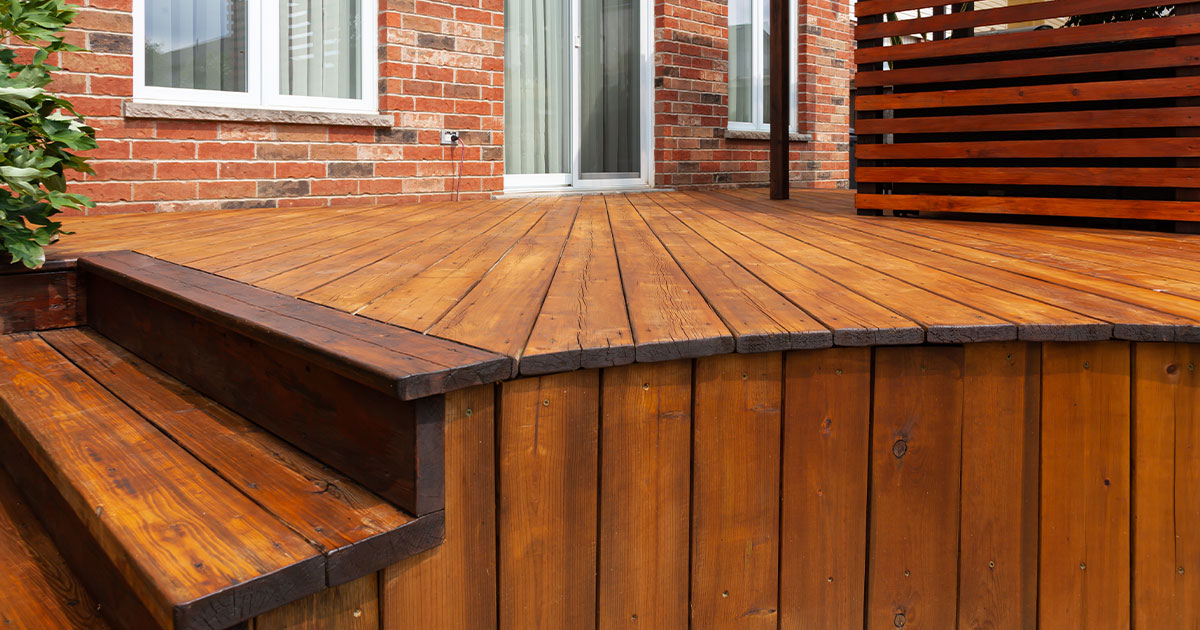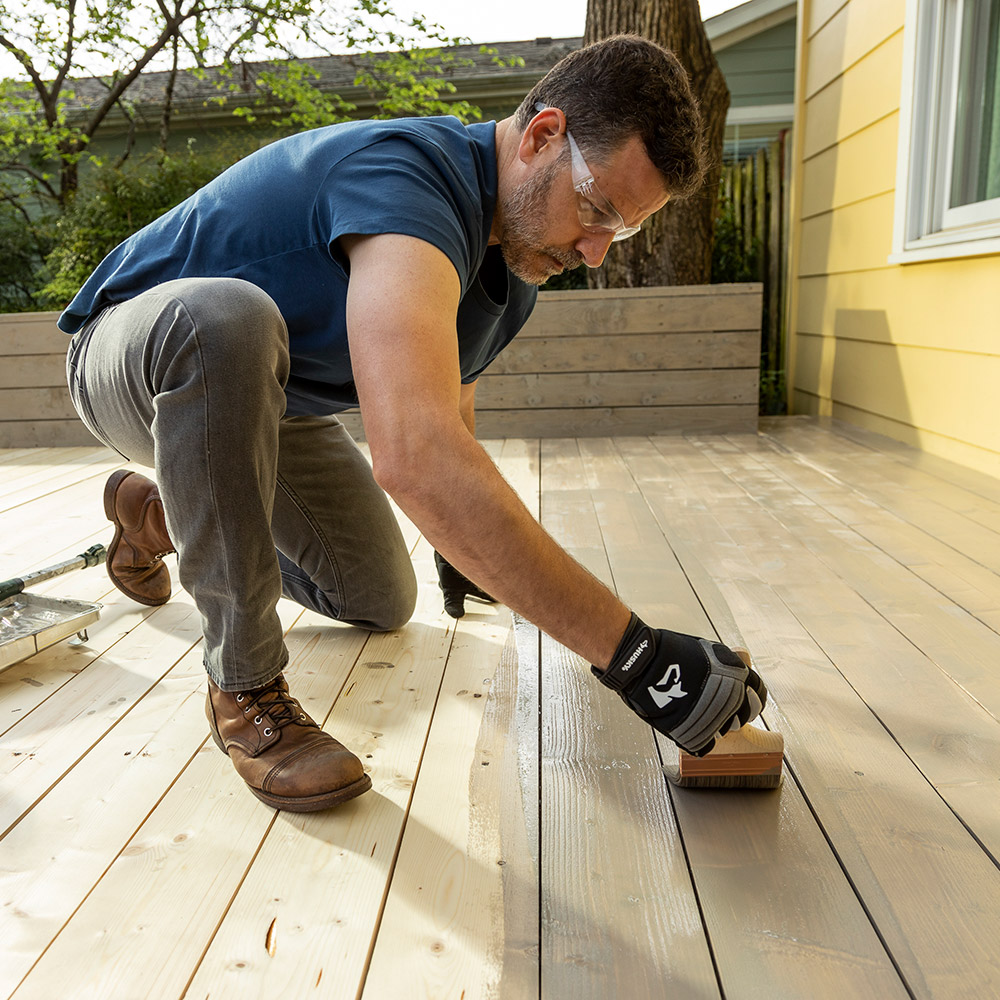Beautiful Deck Designs: The Impact of the Right Stain Choice
Beautiful Deck Designs: The Impact of the Right Stain Choice
Blog Article
A Comprehensive Guide to Various Sorts Of Deck Discoloration Techniques for Ultimate Defense and Aesthetics
In the realm of deck upkeep, the art of tarnishing stands as an essential step in the direction of both protecting the integrity of your exterior room and enhancing its aesthetic charm. As we browse with the intricate world of deck staining strategies, one begins to value the nuanced techniques that can make all the difference in between a sub-par surface and a flawless one.
Recognizing Different Kinds of Stains
Numerous types of spots are commonly made use of in the process of deck discoloration to achieve various visual and protective effects. Clear discolorations are suitable for showcasing the natural grain of the wood while giving minimal defense against UV rays and wetness. On the various other hand, semi-transparent spots supply a balance between color improvement and protection, enabling some timber grain to show with. For an extra nontransparent coating that offers optimum defense against the aspects, strong spots are the preferred option. These spots can be found in a vast array of shades and successfully conceal the wood grain.
Toners include a tip of color to the wood while offering minimal protection, making them suitable for more recent decks with much less wear. Comprehending the qualities and benefits of each type of tarnish is critical for attaining the preferred look and durability for your deck.
Choosing the Right Discoloration Shade
When thinking about the aesthetic appeals of your deck staining project, the choice of stain shade plays a critical function in improving the safety high qualities of the selected discolor type (Beautiful Deck). The color you pick can substantially affect the total look of your deck, in addition to its ability to hold up against the aspects over time
When picking a discolor shade, it's important to consider the existing shade plan of your home's exterior. Balancing the deck stain with the general visual of your residential or commercial property can develop a aesthetically appealing and cohesive exterior space. In addition, the color of your deck discolor can affect the temperature of the deck surface; darker shades have a tendency to take in even more warmth, while lighter colors reflect sunlight and stay cooler.
Moreover, the kind of timber you are staining will also influence how the tarnish shade appears. Different timber species can connect with the tarnish in different means, potentially changing the last shade. It's suggested to evaluate the stain on a tiny, unnoticeable location of the deck to ensure the color transforms out as wanted before waging the entire job.
Preparing Your Deck for Discoloration
To guarantee a long-lasting and successful deck staining job, detailed preparation of the deck surface is necessary. Begin by cleansing the deck thoroughly to remove dirt, grime, mildew, and any type of old discolor or end up. Make use of a deck cleaner or a combination of water and cleaning agent together with a rigid brush or stress washer to scrub the surface tidy. After cleansing, allow the deck to dry totally before moving on to the following action.
Evaluate the deck for any type of damaged or rotten boards that need to be replaced. Hammer down any kind of extending nails and sand any type of rough areas to ensure a smooth surface area for discoloration. Look for any type of loose railings or steps that may require tightening or repair service.
As soon as the deck is clean, completely dry, and in great repair, think about applying a timber brightener to bring back the deck's all-natural color and open the wood pores for far better tarnish penetration. Protect any type of neighboring plants, furniture, or surface areas with plastic bed linen before continuing with the staining process. Correct preparation is essential to attaining a professional-looking coating and optimizing the durability of your deck tarnish.
Applying Spot With Numerous Techniques
For a perfect and professional finish, the technique of using tarnish plays an important duty in enhancing the appearance and see this here toughness of your deck. There are several techniques you can use to make sure a reliable application of stain.
Cleaning is a conventional technique that permits precision and control over the amount of tarnish applied. It is optimal for elaborate locations and reaching in between deck boards (Stain Deck). Rolling is a quicker option, covering larger surface locations successfully. Nonetheless, back-brushing after rolling is recommended to even out the stain and work it right into the timber for far better penetration.
Spraying is one more prominent strategy, supplying rate and ease of application, particularly for big deck areas. Whichever strategy you select, making sure proper prep work and complying with producer guidelines will help attain a lasting and beautiful tarnish coating on your deck.

Preserving and Re-staining Your Deck
Appropriate upkeep and prompt Your Domain Name re-staining are important for preserving the charm and durability of your deck. Regular upkeep tasks include sweeping debris, cleaning up with a deck cleaner, and evaluating for any type of signs of wear or damages. Addressing concerns immediately can protect against extra significant issues in the future. When it concerns re-staining your deck, the frequency relies on numerous aspects such as the kind of discolor used, the environment in your location, and just how much damage your deck experiences. Generally, it is recommended to re-stain your deck every 2-4 years to keep its protection and visual appeals.
Prior to re-staining, guarantee the deck is tidy, completely dry, and complimentary of any kind of previous tarnish deposit. Choose a high-quality tarnish that fits your deck's product and supplies the preferred level of protection.
Final Thought
To conclude, recognizing the different kinds of deck discolorations, choosing the best shade, correctly preparing the deck, applying tarnish with numerous techniques, and keeping and re-staining the deck are necessary steps for supreme security and looks. By following these steps, you can make certain that your deck continues to be in leading condition for several years ahead.
Additionally, the shade of your deck tarnish can affect the temperature level of the deck surface; darker shades tend to absorb even more heat, while lighter colors mirror sunshine and remain cooler.
It's suggested to test the tarnish next on a small, unnoticeable area of the deck to make certain the shade turns out as desired before proceeding with the whole task.

Report this page